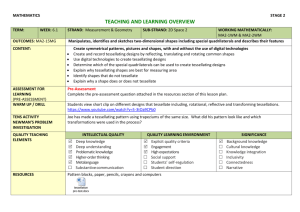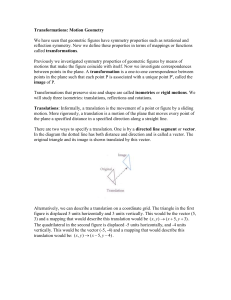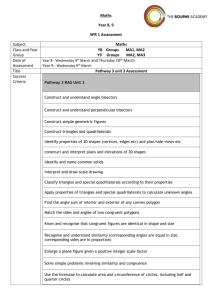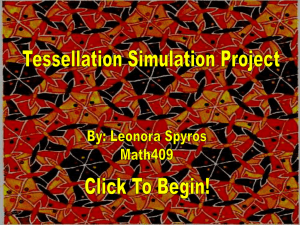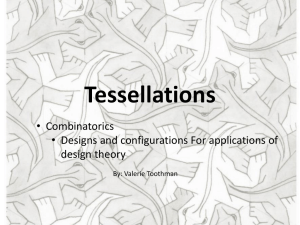The Mathematics of Tessellation
advertisement
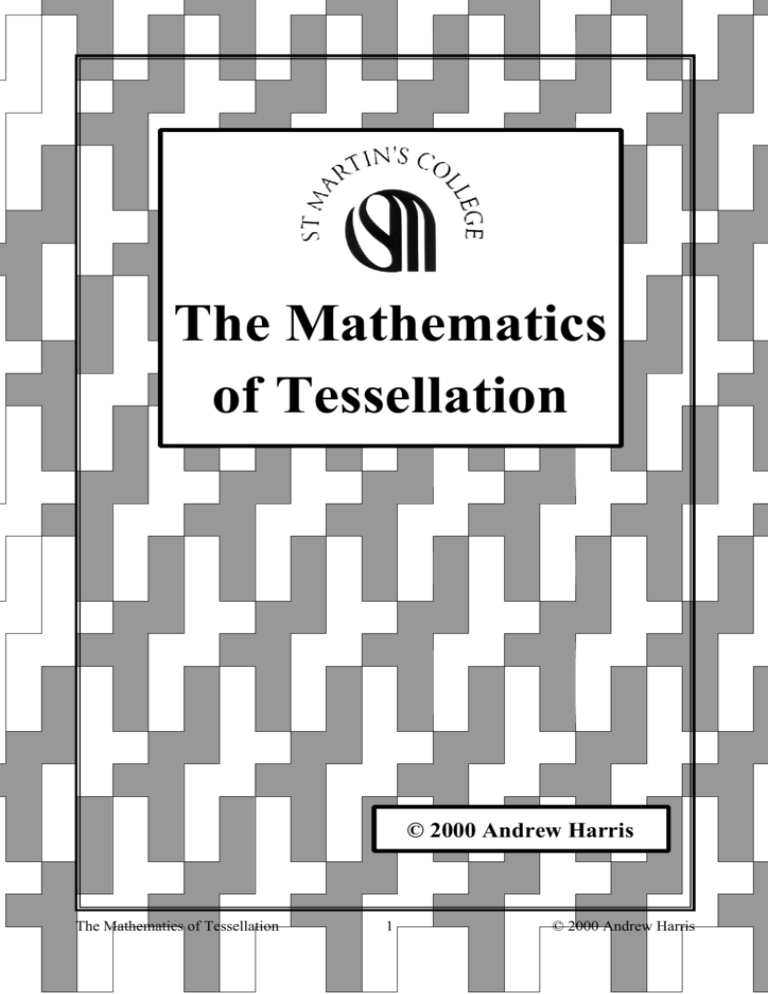
The Mathematics of Tessellation © 2000 Andrew Harris The Mathematics of Tessellation 1 © 2000 Andrew Harris Contents Defining Tessellation.......................................................................................................... 3 Tessellation within the Primary School Curriculum........................................................... 3 Useful Vocabulary for Tessellation ..................................................................................... 3 Prior Knowledge Required for Understanding the Mathematics of Tessellation................ 4 Useful Resources for Teaching Tessellation........................................................................5 Progression in Learning about Tessellation......................................................................... 5 1. Tessellation by Repeated Use of One Regular Shape........................................6 2. Tessellation by Repeated Use of Two or More Regular Shapes....................... 9 3. Tessellation of Triangles and Quadrilaterals..................................................... 11 Preparatory Knowledge for Understanding the Tessellation of Triangles and Quadrilaterals.............................11 (a) Tessellating with Triangles................................................................ 12 (b) Tessellating with Quadrilaterals.........................................................14 4. Tessellation of Irregular Shapes obtained by Mutation of Tessellating Shapes.........................18 The designs of M.C. Escher.................................................................... 19 5. Tessellations involving other irregular shapes.................................................. 21 Use of ICT in Teaching Tessellation................................................................................... 23 Resources Hexagonal Tiling Mats.......................................................................................... 25 Square Tiling Mats - 1........................................................................................... 26 Square Tiling Mats - 2........................................................................................... 27 Square Tiling Mats - 3........................................................................................... 28 Useful References: Tessellation...........................................................................................29 The Mathematics of Tessellation 2 © 2000 Andrew Harris Defining Tessellation A tessellation can be defined as the covering of a surface with a repeating unit consisting of one or more shapes in such a way that: • there are no spaces between, and no overlapping of, the shapes thus employed, and • the covering process has the potential to continue indefinitely (for a surface of infinite dimensions). Tessellation within the Primary School Curriculum Primary school tessellation activities fall into two categories: • • The mathematics of tessellation Application of knowledge about tessellation The ‘application of tessellation’ aspect is often seen in schools and features in most published mathematics schemes. However, the ‘mathematics of tessellation’ aspect is often overlooked. This results in poor progression with children often repeating the pattern-colouring activities they have undertaken in previous years of their schooling. Moreover, such children have little idea of why some combinations of shapes tessellate while others do not. The ‘mathematics of tessellation’ aspect should focus on providing children with the knowledge and skills to explain why tessellation is or is not possible for particular units of shape. It is this which is the basis of good practice for teaching tessellation. That said, it is very worthwhile to show children real-life examples of the application of tessellation. Brick walls, paving, wall and floor tilings, woodblock floors, carpets, wallpapers, wrapping papers, textiles and works of art are often useful resources for whole-class or group discussions about tessellation as a concept and about its application in everyday life. Typical activities when using these might be to identify the repeating unit of shape used to create the tessellation, to explain why the tessellation works, to consider other ways of tessellating the given surface or to develop mental visualisation skills (e.g. as part of a mental/oral starter or plenary within the daily mathematics lesson). Using resources of this kind demonstrate to children the value and purpose of understanding the mathematics of tessellation and thus provide an incentive and reason to learn about it. Useful Vocabulary for Tessellation In common with other aspects of Shape and Space work, children will need to become familiar with the following mathematical vocabulary Plane: Regular shape: two-dimensional or, colloquially, ‘flat’. a shape in which all the sides are the same length AND all the angles are the same size. Irregular shape: a shape in which not all the sides are the same length AND/OR not all the angles are the same size. Polygon: a two-dimensional, closed shape in which all the sides are straight lines. Interior angles: the angles inside the boundary of a shape (see illustration below). Exterior angles: the angles through which one would turn at the corners of a shape if walking around the boundary of the shape (see illustration below). The sum of the exterior angles of any polygon is 360° or one whole turn. Re-entrant angle: an interior angle of more than 180°. Congruent shapes:shapes which are identical in terms of type of shape, lengths of sides and sizes of angles. Their position in space and their orientation may be The Mathematics of Tessellation 3 © 2000 Andrew Harris different. Children will also need to know the names and properties of common two-dimensional shapes. Exterior angles Interior angles interior angle + corresponding exterior angle = 180° Interior and Exterior Angles of a Regular Pentagon Prior Knowledge Required for Understanding the Mathematics of Tessellation In order to be able to understand why some combinations of shapes will tessellate and others will not, children will need to know: • • • • a whole turn around any point on a surface is 360°; the sum of the angles of any triangle = 180° the sum of the angles of any quadrilateral = 360° how to calculate or measure the interior angles of polygons The interior angles of regular polygons (i.e. not other polygons) can be calculated in one of two ways: 1 Divide a whole turn (360°) by the number of exterior angles (= the number of sides) to find the size of one exterior angle. Then use the fact that the exterior angle + the corresponding interior angle = 180° (because angles on a straight line add up to 180°) to find the interior angle. e.g. for a regular pentagon (5 sides, so has 5 exterior angles) the exterior angle = 360° ÷ 5 = 72° so the interior angle = 180° - 72° = 108°. 2 The sum of the interior angles of a n-sided regular polygon = (n - 2) × 180°. Once the total has been calculated in this way, the size of one of the interior angles can be found by dividing by the number of interior angles (= n). e.g. for a regular pentagon (5 sides, so has 5 interior angles) The Mathematics of Tessellation 4 © 2000 Andrew Harris the sum of the interior angles = (5 - 2) × 180° = 3 × 180° = 540° so one interior angle = 540° ÷ 5 = 108°. Note that these methods only work for regular polygons. Measuring the angles with a protractor is possible in all cases, regular or irregular. In summation, children will need to know or learn about the angle properties of all regular polygons and of common irregular polygons in order to understand the mathematics of tessellation. Useful Resources for Teaching Tessellation The following may be found useful when teaching about tessellation: • a large number of various cardboard or plastic regular plane (i.e. flat/2D) shapes each of which have sides of the same length; • gummed paper shapes which have sides of the same length; • tiling mats (obtainable from the Association of Teachers of Mathematics or see Resources section at the end of this booklet) • computer software packages which allow children to investigate tiling and tessellation activities; • real-life examples of tessellation patterns (such as works of art (e.g. by Escher), fabrics, wrapping papers, wallpapers, floor and wall tilings, brickwork patterns); • sets of different kinds of triangles • sets of different kinds of quadrilaterals • sets of irregular shapes (some of which tessellate and some of which do not) • protractors Progression in Learning about Tessellation Several distinct stages can be identified in learning about the mathematics of tessellation. As progress is made through these stages the degree of regularity of the shapes under consideration reduces. The suggested stages in the progression are: 1 Tessellations involving repeated use of ONE regular polygon; 2 Tessellations involving repeated use of a unit of shape made up of TWO OR MORE different regular polygons; 3 Tessellations involving triangles or quadrilaterals; 4 Tessellations of irregular shapes obtained by transformation of other ‘more regular’, tessellating shapes ; 5 Tessellations involving other irregular shapes. The Mathematics of Tessellation 5 © 2000 Andrew Harris 1. Tessellation by Repeated Use of One Regular Polygon Tessellations in which one regular polygon is used repeatedly are called regular tessellations. Initially, children should investigate using sets of 2D shapes to find out which common regular polygons will tessellate and which will not. They should arrive at the following conclusions: • Equilateral triangles will tessellate: • Squares will tessellate: • Regular hexagons will tessellate: • No other regular polygons will tessellate in this way: for example, regular pentagons The Mathematics of Tessellation regular heptagons 6 regular octagons © 2000 Andrew Harris All of the above conclusions can be reached by simply trying each regular shape in turn. It is much harder, however, for children to be able to explain why it is that, of all the regular shapes, only the equilateral triangle, the square and the regular hexagon will tessellate. At this point the prior knowledge outlined on page 4 must be utilised. The key piece of knowledge here is that a whole turn around any point on the surface is 360°. The vertices of six equilateral triangles meet at Point A. Each of the interior angles of the equilateral triangles is 60°. 60° 60° 60° 60° 60° 60° Point A at which the vertices of the six triangles meet. Angle sum around Point A is 60° + 60° + 60° + 60° + 60° + 60° = 6 × 60° = 360° The sum (total) of the angles around Point A is 6 × 60° = 360°. This fact is true of all such points where the vertices of six equilateral triangles meet and thus the equilateral triangles will tessellate. An alternative way to look at this idea is to note that 6 complete equilateral triangles can meet at a common vertex at any point on the surface to be covered (because 360° ÷ 60° = 6, a whole number) and without any gaps being left or any overlapping occurring (because 360° is exactly divisible by 60°). [Note that it does not matter what size the equilateral triangles are (as long as they are all congruent) since the angles will still be 60° whatever the length of the sides.] This tessellation may be represented by the abbreviated notation 36 (signifying that six threesided regular polygons meet at a common vertex). Note this does NOT mean ‘three to the power six’ in this context. You may wish to avoid this notation when working with children because of the potential for confusion with the more usual interpretation of this as ‘three to the power six’. It is included here because of its usefulness for the speedy notation of tessellation patterns involving regular shapes. The same idea can be applied to the tessellation of squares and of regular hexagons: Point B at which the vertices of the four squares meet. 90° 90° 90° 90° Angle sum around Point B is 90° + 90° + 90° + 90° = 4 × 90° = 360° The total of the angles around Point B is 4 × 90° = 360°. Since this is true of all such points where the vertices of four squares meet this explains why squares tessellate. Alternatively, the four complete squares can meet at a common vertex at any point on the The Mathematics of Tessellation 7 © 2000 Andrew Harris surface (because 360° ÷ 90° = 4) and without any gaps being left or any overlapping occurring (because 360° is exactly divisible by 90°). This tessellation may be represented by the notation 44 (four four-sided regular polygons meet at a common vertex). Point C at which the vertices of the three hexagons meet. 120° Angle sum around Point C is 120° + 120° + 120° = 3 × 120° = 360° 120° 120° The total of the angles around Point C is 3 × 120° = 360°. Since this is true of all such points where the vertices of three regular hexagons meet this explains why regular hexagons tessellate. Alternatively, three complete regular hexagons can meet at a common vertex at any point on the surface (because 360° ÷ 120° = 3) and without any gaps being left or any overlapping occurring (because 360° is exactly divisible by 120°). This tessellation may be represented by the notation 63 (three six-sided regular polygons meet at a common vertex). However, if we use a similar line of argument for the other regular polygons we find that: Regular Shape Interior Angle Size 360° ÷ Interior Angle Tessellates? Regular Pentagon Regular Heptagon Regular Octagon Regular Nonagon Regular Decagon ... ... etc. ... ... 108° 128.57° 135° 140° 144° ... 360° ÷ 108° = 3.333 360° ÷ 128.57° = 2.800 360° ÷ 135° = 2.667 360° ÷ 140° = 2.571 360° ÷ 144° = 2.5 ... ... ... ... No No No No No ... Note that, for each shape in the table above, the result of dividing 360° by the interior angle is not a whole number. Consequently, for any of these shapes it is impossible for an exact (whole) number of them to meet at any point on the surface to be covered. Thus, either gaps will be left between them or overlapping of the shapes will occur and therefore none of these shapes can be used to create a regular tessellation. Of all the regular polygons, only the equilateral triangle, the square and the regular hexagon have interior angles such that the result of dividing 360° (a whole turn) by the interior angle is a whole number. Consequently, only these three regular polygons can be used to create regular tessellations. The Mathematics of Tessellation 8 © 2000 Andrew Harris 2. Tessellation by Repeated Use of Two or More Regular Polygons Having explored the tessellating possibilities of single regular polygons children should be asked to investigate which combinations of two or more regular polygons will tessellate and then consider why some combinations are successful and others are not. Tessellations in which: • there are two or more regular polygons around each common vertex, • the tiling around each common vertex is identical are known as semi-regular tessellations. and Children should be taught to identify the repeating unit (composed of 2 or more shapes) in such tessellations. This builds upon the skill of being able to identify the repeating unit in linear patterns such as those made with beads on a string or with multilink which children should have already experienced in previous work. There are 8 semi-regular tessellations to be found. Each is shown below with the abbreviated notation signifying how many of which type of regular polygon are located around each common vertex. 33.42 (3 equilateral triangles & 2 squares) Angle sum around common vertex = 90°+90°+60°+60°+60° = 360° 34.6 (4 equilateral triangles & 1 regular hexagon) Angle sum around common vertex = 60°+60°+60°+60°+120° = 360° The Mathematics of Tessellation 32.4.3.4 (3 equilateral triangles & 2 squares) Angle sum around common vertex =90°+60°+60°+90°+60° = 360° 3.6.3.6 (2 equilateral triangles & 2 regular hexagons) Angle sum around common vertex = 60°+120°+60°+120° = 360° 9 © 2000 Andrew Harris 4.82 (1 square & 2 regular octagons) 3.122 (1 equilateral triangle & 2 dodecagons) Angle sum around common vertex = 150°+60°+150° = 360° Angle sum around common vertex = 90°+135°+135° = 360° 4.6.12 (1 square, 1 regular hexagon, 1 dodecagon) Angle sum around common vertex = 150°+90°+120° = 360° 3.4.6.4 (1 equilateral triangle, 2 squares & 1 regular hexagon Angle sum around common vertex = 120°+90°+60°+90° = 360° For each of these semi-regular tessellations, the sum of the angles around each of the common vertices is 360° and this is the reason why each of these combinations of regular polygons produces a viable tessellation. Other combinations of regular polygons do not produce semiregular tessellations because it is not possible to achieve an angle sum of 360° around each common vertex while maintaining identical tiling around each common vertex. The Mathematics of Tessellation 10 © 2000 Andrew Harris 3. Tessellation of Triangles and Quadrilaterals Up to this point all work undertaken has been with regular polygons. Once the idea has been established that the viability of a potential tessellation is determined by the angle sum around the common vertices of the shapes involved, the child can begin to explore the tessellating propensities of other polygons which are less regular. Two important sets of irregular polygons that should be investigated are triangles and quadrilaterals. Preparatory Knowledge for Understanding the Tessellation of Triangles and Quadrilaterals Children will need to learn that: • the sum of the angles in a triangle is 180°; • the sum of the angles in a quadrilateral is 360°. The Sum of the Angles in Any Triangle The fact that ‘sum of the angles in a triangle = 180°’ is usually ‘proved’ to children by asking them to draw on paper any old triangle with angles A, B and C. The triangle is cut out with scissors and the corners of the triangle are then torn off and arranged as shown below: tear off corners & arrange on a straight line B C B A A C The fact that the angles A, B and C can be arranged to lie on a straight line (check with a ruler) indicates that for this triangle the sum of the angles is equal to a half-turn or 180°. If several children attempt this each with different triangles it can be shown to work for several triangles. This is then usually accepted as adequate evidence that the sum of the angles of any triangle = 180°. Note that this procedure does not constitute a rigorous mathematical proof of this mathematical statement since there are an infinite number of possible triangles and therefore not all triangles have been tested by the procedure outlined above. However, it is usually considered an adequate basis upon which to proceed for children at this level of mathematics. The visual nature of the ‘proof’ helps to convince children of the truth of the hypothesis. The Sum of the Angles in Any Quadrilateral The fact that ‘the sum of the angles in any quadrilateral = 360°’ can be ‘proved’ in a similar way to the procedure outlined above for triangles. Draw any quadrilateral, tear off the corners and arrange around a common point: The Mathematics of Tessellation 11 © 2000 Andrew Harris B C tear off corners & arrange around a common point A D A C B D Then use the fact that a whole turn = 360° to deduce that A + B + C + D = 360° and so ‘prove’ that the sum of the angles of any quadrilateral = 360°. Note that the same reservations expressed above (regarding the procedure for ‘proving’ the angle-sum of triangles) about lack of mathematical rigor apply in this case also. Triangles and quadrilaterals can be explored in relation to their tessellating propensities by either presenting the task as a pair of investigations (i.e. Which triangles tessellate? Which quadrilaterals tessellate?) or as a pair of hypotheses (‘All triangles tessellate’, ‘All quadrilaterals tessellate’) which children are asked to test and so either prove them or disprove them. (a) Tessellating with Triangles An initial exploration of a few different types of triangles leads one to suppose that most triangles will tessellate: Different types of isosceles triangles The Mathematics of Tessellation 12 © 2000 Andrew Harris Right-angled triangles Scalene triangles In fact, any triangle can be used as a repeating unit with which to tessellate. In order to prove this, children can make use of what they already know, namely, a whole turn about any point on the surface is 360°. In addition to this, children will also need to know that the sum of the angles of any triangle is 180° (see earlier section ‘Preparatory Knowledge for Understanding the Tessellation of Triangles and Quadrilaterals’). If it can be established that, for any triangle, the sum of the angles around any common vertex is always 360° this will ‘prove’ that all triangles tessellate. A This can be done simply with children by asking them to draw with a ruler any triangle with angles labelled A, B and C. B C C A B B C A C A A C B B C A B C A A C B B C A B C A B A C B B C A B A C B A C B We know that A + B + C = 180° The Mathematics of Tessellation A C B A C B This triangle is then replicated and the triangles arranged so that around any common vertex there will be from the various triangles involved two of each of the angles A, B and C. A C (because the sum of the angles in any triangle is 180° or, alternatively, because A, B and C form a straight line) 13 © 2000 Andrew Harris and around any common vertex the sum of the angles = (A + B + C) + (A + B + C) = 180° + 180° = 360° Thus, any triangle can be used as a repeating unit for tessellating. (b) Tessellating with Quadrilaterals A similar exploration of the tessellating properties of different types of quadrilaterals can be undertaken. As a result of the properties of various quadrilaterals, there may be more than one way in which a particular quadrilateral may tessellate. For example, there are many ways of tessellating with rectangles. These are just a few: Brickwork patterns are often a rich source of everyday examples of such tessellations. Initial explorations involving quadrilaterals suggest that, like triangles, most quadrilaterals can be used as a repeating unit with which to tessellate: Tessellating with a rhombus The Mathematics of Tessellation 14 © 2000 Andrew Harris Some other possible tessellations using a rhombus When tessellating with a parallelogram, children are likely to discover that they can produce similar tessellations to the first two rhombus tessellations given above. A trapezium or kite will also tessellate: Tessellating with a trapezium Tessellating with a Kite It is also worth asking children to investigate quadrilaterals which have re-entrant angles such as the ‘dart’ which also tessellates: tessellating with a ‘dart’ After some exploration, children should begin to form the hypothesis that ‘all quadrilaterals can The Mathematics of Tessellation 15 © 2000 Andrew Harris be used as a repeating unit with which to tessellate’. This hypothesis can be ‘proved’ geometrically in a similar way to that for triangles. Again, it relies on the fact that a whole turn around any point on the surface to be tessellated is 360°. This time, however, children will also need to know that the sum of the angles in any quadrilateral = 360° (see earlier section ‘Preparatory Knowledge for Understanding the Tessellation of Triangles and Quadrilaterals’). If it can be established that, for any quadrilateral, the sum of the angles around any common vertex is always 360° this will ‘prove’ that all quadrilaterals can be used to tessellate. B C Children are asked to draw any quadrilateral using a ruler and pencil. A D This is then used to tessellate in such a way that around any common vertex there will be (from the 4 quadrilaterals which meet there) one of each of the angles A, B, C and D as shown below: A B D C D A B C C B B A C D A D C A B D C B A D C A B B A C D B A C D B A C D D A D C A B D C A B B C B A C D D A D C B A D C B The Mathematics of Tessellation 16 © 2000 Andrew Harris Given that we know the angle sum of any quadrilateral to be 360° then A + B + C + D = 360° Since the angles around any common vertex are precisely A, B, C and D and so must total 360°, we can then state that ‘all quadrilaterals can be used as a repeating unit with which to tessellate’. A tessellation using a combination of two quadrilaterials. The repeating unit contains 3 kites and 1 rhombus. The Mathematics of Tessellation 17 © 2000 Andrew Harris 4. Tessellation of Irregular Shapes obtained by Transformation of Other Tessellating Shapes It is possible to produce some very irregular shapes which will tessellate by transforming other shapes which are known to tessellate. These irregular shapes include shapes bounded by curved lines (up until now only shapes with straight sides have been considered). Squares, rectangles, equilateral triangles and hexagons are suitable shapes from which to start. By translating or rotating about the mid-point of any side sections of the starting shape (or a combination of both) a new, irregular shape can be made which will also tessellate. Some examples of this are given below: Translating a Section of a Square The original square A section of the original square is moved by translating (sliding) it to the opposite side of the square. The resulting tessellation Rotating Sections of a Square The original square A section of the original square is moved by rotating it about the midpoint of the side of the square. A similar rotational process is applied to another side of the square. The resulting tessellation The same methods can be applied to rectangles, equilateral triangles and regular hexagons. The Mathematics of Tessellation 18 © 2000 Andrew Harris To explain why these irregular shapes tessellate is more difficult than for previous cases encountered in Sections 1 - 3 and is usually considered to be beyond the level expected of primary school children. The following explanation is included for subject knowledge purposes. The argument that, around any common vertex within the tessellation, the sum of the angles is 360° is still true but this is now complicated by the fact that the boundary of the repeating unit may include curved lines. Where curved lines are involved, we use the tangents to the curves to define the limits of the angles: a d c b The dotted lines are the tangents to the curves at the common vertex. The angles a, b, c and d are the angles between the tangents (dotted lines) and as before a + b + c + d = 360° Practical Work with Children The designs of M.C. Escher owe much to this idea of transformation of shapes to create new, irregular, tessellating shapes. Examples of Escher’s work are useful resources for inspiring children to create their own designs in a similar style. Escher’s Lizard Tessellation: A hexagonal grid has been superimposed on this tessellation to show how it has been created. It uses a replicating Lizard tile made from a regular hexagon which has undergone several mathematical transformations. The Mathematics of Tessellation 19 © 2000 Andrew Harris Left: Escher’s Flying Horse tessellation Right: Escher’s Birds tessellation The simplest way in which to do this type of work with children is to use a gummed paper shape as the initial shape. Sections of this gummed paper shape can then be cut out and either translated or rotated appropriately into their new positions. All of the pieces of gummed paper can then be stuck to cardboard. Cutting around the outline of the transformed gummed paper shape will create a template. This can then be used as the repeating unit for a tessellation. Effective displays of children’s work can be created if colour is used to emphasise the different arrangements of the repeating unit within the tessellation. The Mathematics of Tessellation 20 © 2000 Andrew Harris 5. Tessellations involving other irregular shapes At this stage, it becomes sensible to widen the range of shapes to include all irregular shapes. Some examples of activities might be ... ... investigating irregular polygons: e.g. irregular pentagons or or (This is useful to consider with children in order to avoid/confront the misconception that ‘pentagons don’t tessellate’ which arises when children over-generalise the non-tessellation of regular pentagons and thereby assume that it is impossible to tessellate with any pentagon). There are, currently, 14 known irregular pentagons which tessellate but no-one, to date, is certain if any more exist. ... using letters of the alphabet: H-shapes The Mathematics of Tessellation Y-shapes E-shapes 21 © 2000 Andrew Harris ... or shapes derived from circles: e.g. using to produce ... or to investigate the tessellating possibilities offered by the various sets of polyominoes (extension of the idea of the domino): The set of triominoes The set of tetrominoes Shapes composed of 3 squares Shapes composed of 4 squares All of the triominoes and the tetrominoes can be used as a repeating unit with which to tessellate. Shapes composed of 5 squares. Only some of these can be used as repeating unit with which to tessellate. The set of 12 pentominoes The Mathematics of Tessellation 22 © 2000 Andrew Harris Hexominoes are composed of 6 squares (there are 35 of these). Each of these will tessellate. Similar tessellation investigations can be carried out with polyiamonds (similar to polyominoes but made of equilateral triangles instead of squares): etc. The set of triamonds (just one!) The set of tetriamonds Use of ICT in Teaching Tessellation There are several ICT software packages which address aspects of tessellation. Most common are dedicated ‘tiling’ packages which allow children to select from a range of different polygons and use them to tessellate, thereby using the computer screen as the surface to be covered. The advantage of using such a software package to do this is that it is relatively easy for a child to obtain a paper-based record of his or her work via a printer and it bypasses the tedious and time-consuming aspects of tessellating (drawing round templates and colouring in). There are obvious advantages in relation to presentation of children’s work as well. If the computer is linked to a large monitor, a large TV or a data-projector then a software package may be used as a resource for direct teaching and discussion (perhaps within the mental/oral starter or plenary of the daily mathematics lesson). However, there are also some disadvantages involved with using ICT packages for this purpose. One is that it is often difficult to measure and/or angles within shapes on a computer screen. the screen size and resolution may also be a problem. Most packages limit the types of shapes available to children (often to just regular polygons and perhaps a few common irregular shapes such as rectangles). In some packages the emphasis is on making patterns (i.e. the application of tessellation to design) rather than on the mathematical aspects of tessellation. Both of these areas of knowledge have their value but it is important to identify which of these aspects a software package addresses. The best tiling packages allow the user to design their own ‘tile’ or repeating unit of shape(s). The very best of these allow the user to translate or rotate portions of tessellating shapes so as to form new, irregular, tessellating shapes (by the procedures outlined previously in the section ‘Tessellation of Irregular Shapes obtained by Transformation of Other Tessellating Shapes’) which can themselves be used to tessellate across a surface. Logo packages are also useful tools for exploring tessellation. When using Logo the onus is on the child: • to consider the interior and exterior angles of the shapes they are using (thus developing their understanding of the mathematical reasons for tessellations being feasible or infeasible), • to identify what constitutes the repeating unit for their tessellation, and • to recognise how the repeating unit is replicated within that tessellation. The Mathematics of Tessellation 23 © 2000 Andrew Harris The usual approach to tessellation with Logo is to encourage children to build up towards a completed tessellation as follows: 1 Create one or more sub-procedures which generate each of the shapes involved in the replicating unit; 2 Write a further sub-procedure which uses the shape sub-procedures to draw the unit of shape(s) that will be repeated; 3 Create a final procedure which: a) calls the sub-procedure that draws the repeating unit of shape(s); b) repositions the turtle to draw the next repeating unit of shape(s); c) repeats steps (a) and (b) until the desired surface area has been covered. Just as for any other area of mathematics in which ICT is used, it is important to consider whether the use of ICT is the most suitable tool/resource for achieving the desired learning or teaching objectives and thereby use ICT as a means of teaching or learning only when it is appropriate. Resources The photocopiable sheets of tiling mats which follow can be photocopied onto card or paper and cut up to provide a selection of shapes for tiling large areas. Typical activities for using these with children are: • creating tessellations which show different repeating patterns. How many patterns are possible? • creating tessellations with closed or open patterns • creating tessellations so that the pattern has the maximum number of regions possible • is it possible to make pattern, make a larger version of the pattern which encloses the first, and an even larger version enclosing that.... and so on? • make a design with as many ‘triangles’ as possible. • create a pattern and investigate what happens if you slide one row of mats sideways • How many mats are needed to make the smallest possible square? And how many are required for a slightly larger square? And the next square? • creating tessellations which spell particular letters of the alphabet, words or numbers • creating tessellations which have different kinds of symmetry (reflective, rotational, translational) • design your own tiling mat by drawing or using the computer. How versatile is it? Use of these tiling mats adds an additional dimension to tessellation activities since, in addition to considering the position of each regular polygon within the tessellation, the children also have to think about the orientation of each tile and its contribution towards the pattern created as well. Tiling mats are also good for encouraging collaborative work and for developing the use and understanding of mathematical language. They also have uses in the teaching of area: for example, estimating and calculating how many tiling mats are needed to cover a given area (table-top, home corner, hall floor etc.). The Mathematics of Tessellation 24 © 2000 Andrew Harris Hexagonal Tiling Mats The Mathematics of Tessellation 25 © 2000 Andrew Harris Square Tiling Mats - 1 The Mathematics of Tessellation 26 © 2000 Andrew Harris Square Tiling Mats - 2 The Mathematics of Tessellation 27 © 2000 Andrew Harris Square Tiling Mats - 3 The Mathematics of Tessellation 28 © 2000 Andrew Harris Useful References: Tessellation Deboys, M. & Pitt, E. Wells, D 1979 Lines of Development in Primary Mathematics Blackstaff Press 1991 The Penguin Dictionary of Curious and Interesting Geometry Penguin Some Web site URLs http://www.shodor.org/interactivate/activities/tessellate/index.html http://users.erols.com/ziring/escher.htm http://www.djmurphy.demon.co.uk/escher.htm http://www.camosun.bc.ca/~jbritton/jbaraki.htm http://www.camosun.bc.ca/~jbritton/jbsymteslk.htm http://www.etropolis.com/escher/ http://www.iproject.com/escher/escher100.html http://www.uvm.edu/~mstorer/escher/artgallery.html http://www.WorldOfEscher.com/ The Mathematics of Tessellation 29 © 2000 Andrew Harris


